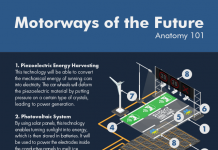by Clean Energy Intel
Nissan Leaf (Left) & Landglider at the 2009 Tokyo Motor Show. Image source: Wikipedia / Tennen-Gas
Nissan and its sister company Renault have clearly made a commitment to ‘advanced-drive’ autos.
The facts speak for themselves:
- Nissan put the Leaf on the streets in December of 2010 – the first mass-produced, battery electric vehicle. Sales reached 15,000 units worldwide by September of this year.
- Nissan-Renault CEO Carlos Ghosn has said he expects sales of BEVs to make up 10% of the sales of new light-duty vehicles by 2020.
- The combined companies are investing $5bn in electric drive vehicle development.
- The two companies have said they will produce 8 different EVs by 2015.
Two new developments at Nissan illustrate the fact that the company is keeping its options open in terms of which new alternative fuel technologies will in the end be the winners.
Firstly, Nissan has developed a new hybrid powertrain which, when released in 2013, will combine an electric motor with the new XTRONIC continuously variable transmission (CVT). The CVT itself is capable of improving fuel economy by as much as 10 percent because of ‘modified parts, a smaller fuel pump and use of lower-viscosity oil, all of which cut friction by as much as 40 percent….. The system, paired with a 2.5-liter turborcharged engine, provides the power of a 3.5 liter engine but with much better city and highway fuel economy’ according to a report by AutoObserver.
Nissan has of course been producing hybrids for some time – in the US with the Altima Hybrid, for example, and the Infiniti M35, which was released this July. Neither model has seen much success – mainly since the hybrid field is heavily dominated by the Prius.
Perhaps of more interest then, is Nissan’s suggestion that the company has also built a fuel-cell stack for hydrogen fuel-cell electric vehicles (FCEVs) that provides more than double the power density of the fuel stack the company developed in 2005 at about one-sixth the cost. This from AutoObserver’s report:
Nissan achieved this by changing the fuel cell stack’s structure to cut its size in half while reducing the use of platinum and the total number of parts by 75 percent, the company said. The automaker said it also made cost- and size-cutting improvements to the fuel-cell stack’s separator flow path, which separates hydrogen, air and cooling water with stamped thin metal plate.
The news that significant progress has been made in getting the amount of platinum used in fuel cells down is good news since the platinum content of the cells has been a major factor in keeping the fuel cell less than economical.
Perhaps hydrogen fuel-cell electric vehicles will make a renewed impact once again. The key is the ability of the various automakers currently on route to put FCEVs on the market by 2015 to get costs down. From this perspective, Nissan’s news certainly raises an eyebrow.
Disclosure: I have no positions in the stocks discussed.
About the Author: Clean Energy Intel is a free investment advisory service (available at www.cleanenergyintel.com), produced by a retired hedge fund strategist who also manages his own money inside a clean energy investment fund.









